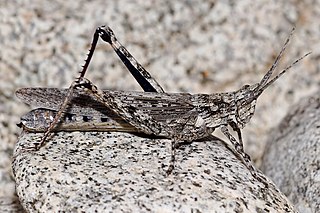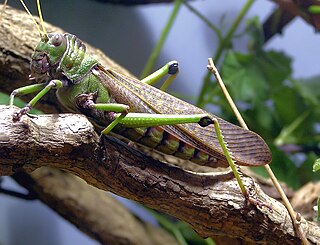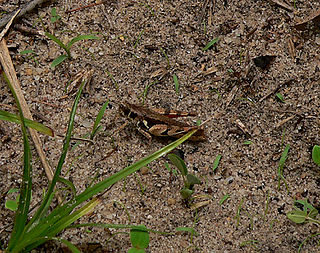
The Acrididae are the predominant family of grasshoppers, comprising some 10,000 of the 11,000 species of the entire suborder Caelifera. The Acrididae are best known because all locusts are of the Acrididae. The subfamily Oedipodinae is sometimes classified as a distinct family Oedipodidae in the superfamily Acridoidea. Acrididae grasshoppers are characterized by relatively short and stout antennae, and tympana on the side of the first abdominal segment.

The grasshopper subfamily Acridinae, sometimes called silent slant-faced grasshoppers, belong of the large family Acrididae in the Orthoptera: Caelifera.

The Romaleidae or lubber grasshoppers are a family of grasshoppers, based on the type genus Romalea. The species in this family can be found in the Americas.

The Verophasmatodea suborder of the Phasmatodea contains the vast majority of the extant species of stick and leaf insects.

The subfamily Pseudophyllinae contains numerous species in the family Tettigoniidae, the katydids or bush crickets. Sometimes called "true katydids", together with the crickets of suborder Ensifera, they form part of the insect order Orthoptera which also contains grasshoppers.

The Phaneropterinae, the sickle-bearing bush crickets or leaf katydids, are a subfamily of insects within the family Tettigoniidae. Nearly 2,060 species in 85 genera throughout the world are known. They are also known as false katydids or round-headed katydids.

Chorotypidae is a family of tropical Asian grasshoppers, formerly included within the family Eumastacidae. These grasshoppers have a head that rises above the level of the thorax and short antennae. Some species have reduced wings, others have wings that widen towards the tips and still others have a flattened leaf-like shape. They lack abdominal tympani.

Oxyinae is subfamily of grasshoppers in the family Acrididae. Species are distributed throughout Africa and Australasia.

Catantopini is a tribe in the subfamily Catantopinae, a group of grasshoppers found in Africa, Asia and Australia.

The Coptacrinae are a subfamily of Acrididae in the Orthoptera: Caelifera. Species can be found in Africa and Asia.

The Eyprepocnemidinae are a subfamily of Acrididae in the Orthoptera: Caelifera. Species can be found in Africa, mainland Europe and Asia.

Ceracris is a genus of grasshoppers in the family Acrididae, subfamily Oedipodinae, found in tropical Asia. C. kiangsu is the yellow-spined bamboo locust which infests Indo-China and southern China.
Letana is a genus of bush cricket: characteristic of the tribe Letanini and placed in the subfamily Phaneropterinae. Species can be found in Asia: mostly India, China and Indo-China.

Callimenellus is an Asian genus of bush crickets in the subfamily Pseudophyllinae. It is the sole genus in the tribe Callimenellini.
Hemigyrus is an Asian genus of bush-crickets in the tribe Phyllomimini and the subfamily Pseudophyllinae. Species have been recorded from: southern China and Indo-China.
Typhoptera is an Asian genus of bush-crickets in the tribe Cymatomerini and the subfamily Pseudophyllinae. Species are recorded from India, Indo-China and Malesia.
Ectadia is a genus of Asian bush crickets of the tribe Elimaeini.
Stonychophora is a genus of camel crickets in the tribe Rhaphidophorini. Species in this genus can be found from Indo-China and Malesia to New Caledonia.
Gerenia is a genus of grasshoppers in the subfamily Catantopinae and tribe Gereniini. Species can be found in India and Indo-China.
Melaneremus is a genus of Orthopterans, sometimes known as 'leaf-folding crickets' in the subfamily Gryllacridinae and tribe Gryllacridini. The recorded distribution is: the Indian subcontinent, China, Indochina, western Malesia and western Pacific islands.












